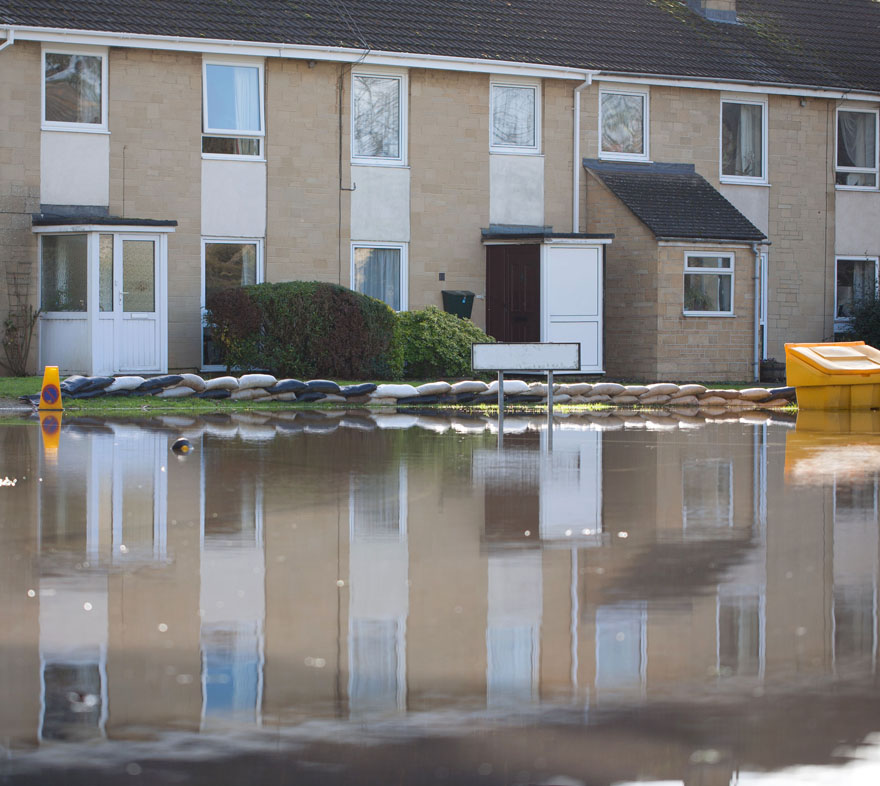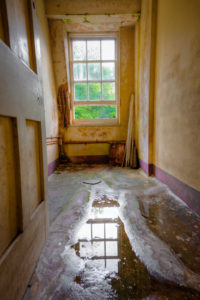
Anne Morgan-Davies, BRUFMA member and Projects Coordinator at Isothane, highlights the need to carefully consider the type of insulation selected for buildings that have been, or could be, exposed to the effects of flooding.
When you consider that 5.5 million or one in six homes across the UK is at risk of flooding and that one new home in every 14 is constructed on land that has a significant chance of flooding, local authorities can do much to increase the resistance and resilience of their housing stock to flood damage.
The climate is changing and the frequency of flooding events across the UK in recent years has put into question how to make UK homes more resilient to cope with our increasingly damaging weather. DEFRA’s Property Flood Resilience Action Plan outlines in detail the sort of measures that can be taken by a variety of stakeholders to make people and their property less vulnerable to the physical and psychological impacts of flooding.
 Property level resilience
Property level resilience
Flood waters can penetrate unprotected properties and cause major damage to the walls, cavity ties, fibre based cavity wall insulation materials, plaster, decorations and so on. For residents, this can cause misery, upheaval, disturbance as well as great financial hardship. It’s important to limit damage in order to speed up drying time to enable the resident’s reoccupation by making the inside of homes resilient to floodwater.
Flood resilient technologies can now provide a cost-effective method of flood protection. From flood doors to barriers, waterproofing brickwork to one-way valves in drainage pipes as well as rigid floor and wall insulation, when innovative measures are undertaken, homes can be quickly cleaned, dried and reoccupied with minimal disruption to the residents.
Bouncing back from water ingress
The British Standard on flood resilience, BS 85500, provides guidance on both new-build and retrofit applications and highlights that flooding situations require a combination of resistance and resilience with specifiers needing to carefully consider the type of insulation for cavity wall applications for buildings that have been or could be exposed to flooding.
Rigid PIR insulation, available as pre-formed boards and PUR insulation, which can be injected or spray applied, with its closed-cell structure, can help to increase a building’s resilience, reducing the economic and emotional damage caused to its owners by flooding. Products made from this material, injected into a cavity, offer the added benefits of being able to retain structural integrity while resisting the absorption of moisture as well as offering a high thermal performance.
 Among its wide-ranging look at flood resilience and resistance including planning issues, BS 85500 bases guidance around materials’ specification on the major independent report commissioned by DCLG in 2007 entitled ‘Improving the Flood Resilience of New Buildings’. This provides a revealing comparison of materials for achieving flood resilience in cavity wall and floor constructions, giving rigid PU a ‘Medium’ rating for both water penetration and drying ability (with water-retaining mineral wool and blown-in expanded mica rated ‘Poor’ for both factors). On ‘retention of pre-flood dimensions and integrity’, rigid PU benefits further from its closed-cell structure’s water resistance with a ‘Good’ rating (the highest rating awarded in the report’s findings on walls).
Among its wide-ranging look at flood resilience and resistance including planning issues, BS 85500 bases guidance around materials’ specification on the major independent report commissioned by DCLG in 2007 entitled ‘Improving the Flood Resilience of New Buildings’. This provides a revealing comparison of materials for achieving flood resilience in cavity wall and floor constructions, giving rigid PU a ‘Medium’ rating for both water penetration and drying ability (with water-retaining mineral wool and blown-in expanded mica rated ‘Poor’ for both factors). On ‘retention of pre-flood dimensions and integrity’, rigid PU benefits further from its closed-cell structure’s water resistance with a ‘Good’ rating (the highest rating awarded in the report’s findings on walls).
The report recommends that floor insulation should be of the closed-cell type to minimise the impact of floodwater. Whether it is installed above or below the floor slab, the location is usually based on either achieving rapid heating of the building or aiming for more even temperature distribution with reduced risk of condensation.
Flood resilient and energy-efficient homes
A project carried out by the BRE demonstrates how the combination of good design and the use of building materials and product innovation can help limit property damage and ensure residents recover quickly from flooding issues. Different types of water-resilient insulation have been used in the demonstration house, including injected cavity wall insulation, PIR insulation boards for walls and floors and PUR spray insulation. Other practical issues have also been addressed, such as how to improve floor insulation and seal-off areas where water could enter the property.
Rigid closed-cell PUR insulation is the best performing material when installed into the cavity walls as it retains integrity and has low moisture take-up. If flooding were to occur it would not allow the ingress of water through the cavity into a property. Once the flood water recedes, the closed-cell system remains serviceable whereas other forms of insulation would need to be replaced causing disruption and great expense.
Delivering flood resilience to homes will ultimately reduce the misery and disruption faced by thousands of residents across the UK. In a package of measures, the use of rigid closed-cell insulation will make cavity walls flood resilient, preventing flood waters penetrating the walls as well as improving the structural strength of the walls to withstand the forces of any future flood waters. As well as making homes more thermally efficient through upgraded thermal insulation, this solution is built into the fabric of the building and will tackle the flood threat head-on.








